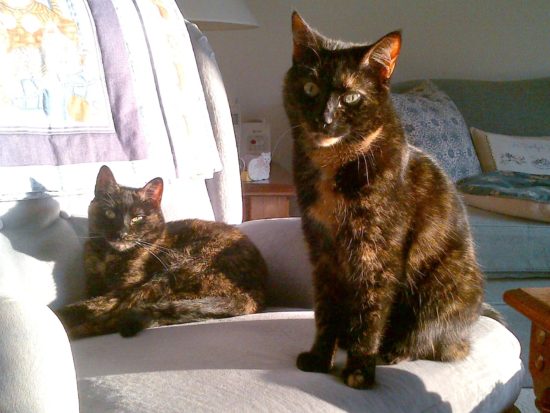
Laura Cassiday is a certified cat behavior consultant (CCBC) and owner of Pawsitive Vibes Cat Behavior and Training. Laura is certified through the International Association of Animal Behavior Consultants. She is also a Fear Free certified animal trainer. Laura recently published her first book, The Complete Guide to Adopting a Cat (affiliate link*.) She works with cat guardians remotely from all over the world, as well as in-person in her local area of Baltimore, Maryland. For more information, visit Pawsitive Vibes Cat Behavior and Training.
Do you have a question for Laura?
Leave it in a comment, and she’ll answer it next month!
A note from Ingrid: My apologies for the long wait to those of you who have asked Laura questions in September. Laura has been extremely busy (which is a good thing for her, and for all the cats she’s helping!)
Very active cat gets overstimulated easily
Hi Laura!
This column has always been so helpful and I wanted to welcome you and thank you for the wonderful information that you pass along. I work at a cat rescue and we house our cats in small rooms with catios.
I wanted to ask about a cat in particular that we have taken in from another rescue – he was returned to them twice due to his behavior that involves “grabbing” peoples arms/legs with both his claws and teeth. He often just grabs on and then pretty quickly lets go – but hard enough to leave marks.
he is only about 2 years old, is very active and gets overstimulated quickly. We have had him about months and have worked extensively with him -interactive play, scent work, clicker training where we have tried to direct his attention to the toys vs body parts and we always bring a shield in his room just to be able to cover any body parts he might go after. he did great in the beginning and loved play time and improved to where he would relax on the couch with a visitor and snuggle with them- although we still had a number of incidents where he would get around the shield on volunteers and grab them.
But things have changed and now he often seems to be disinterested in play – often preferring to hump his pillow instead.
We even have an outdoor play yard that he gets to enjoy once or twice a week – but even when he is outdoors and running off his energy he has run at people and “grabbed” them.
So I want to ask if you have any ideas on how we can further work with him to change this grabbing behavior – we can often see it coming on – he seems overstimulated and paces around and rubs on everything and just can’t focus or settle, and possibly how we can get him motivated to play once again – we’re thinking he’s probably bored but his behavior also makes it difficult to find the right adopter for him.
Thank you! – Karen
Hi Karen,
It sounds like you’ve already done a ton for this cat in terms of trying to meet his activity level and higher-than-average needs. I think you hit the nail on the head that he seems overstimulated. Sometimes I find it easier to explain this phenomenon by pulling an example from the dog world. Imagine you had a highly active sporting breed dog, like a Border Collie. You take him on runs twice a day, play fetch in the yard, hiking, agility, flyball, etc. and he gets a ton of exercise and stimulation. One weekend you decide that you want to take it easy and sleep in and watch TV. But because you’ve set such a high standard in terms of exercise and stimulation, it’s impossible. Your dog jumps up on you, becomes mouthy, and starts to destroy your house. He never learned how to settle down on his own, because he’s always on the move. Sleep and relaxation are a necessity, not a hobby.
Karen Overall has a wonderful protocol for teaching relaxation that I suggest you look into. Mat training, clicking for calm behavior, and rewarding relaxation can work wonders in these types of cats who just can’t get enough. The fact that he isn’t playing or engaging likely means that stress is factoring into the behavior as well. Humping can be a self-soothing behavior or stress reliever. I wonder if speaking to your vet about behavior medication or possibly trying to get him into a different environment could be helpful. Good luck!
Peeing outside the litter box
Household of five cats, four females, one male. Six litter boxes and enough areas to climb and/or “hide.” Female cat #2, age 5 yrs with no current UTI or crystals and on a Urinary S/O food. Keep litter boxes clean but she’ll pee in the box, outside the box, and in other areas of the house. Not a new behavior but also not a behavior the first few years of her life. She prefers to hang out on her cat tree and doesn’t socialize much with the other cats. Currently trying Prozac but that doesn’t seem to be helping. I’d love to know what other options to consider because pee hide and seek is not a game I want to continue to play. – Rebecca V.
Pee problems are never any fun. They can also be a bit of a guessing game. I try to solve litter box problems by first identifying a cause for the behavior. Is it stress-related? Possibly. You mention that she stays in one place and doesn’t much interact with the other cats. Is it caused by a medical issue? Sometimes, if she’s had UTIs in the past, she may have developed an aversion or negative association with the litter box that continues after she feels better. Is it territorial? Probably not, unless you are seeing vertical spraying. Or finally, is it general litter box avoidance, meaning she just isn’t happy with her litter box situation? Probably. I find that’s almost always a component when cats are going outside of the box. For your situation, I would make sure that she has plenty of convenient options, starting with placing a box near the cat tree where she hangs out. If she wants to avoid the other cats, give her the option to. You didn’t mention where the six litter boxes are, but if they are next to each other or in the same room, you’ll want to spread them out. Try using large, open, uncovered boxes with plain unscented clumping clay litter, which is what the average cat tends to prefer.
Traveling with two cats
Hi Laura
I have two Siberians that will be 2 years old next month. I live in South Florida and I have a vacation home in North Carolina. Every time we go to North Carolina I have a pet sitter come and stay overnight with my cats for that length of time. However we would like to go for longer Stays and I want to bring my kittens with me. How can I get them used to traveling in the summers and feeling comfortable in the other home? I would appreciate any advice you can give me. Thank you so much. – Cathy
Cats are very territorial, and moving back and forth isn’t something that they would ever do naturally. It’s likely to be a stressful situation for them no matter what. However, if it’s what must be done, it’s what must be done. The first thing I would start with is acclimating them to a crate or carrier they’ll be traveling in. I like to use large dog crates for long car rides that can accommodate a bed, litter box, and food and water. You can cover them with a blanket to help keep the cat calm during the trip. Bring out the crate or carrier you’ll be using and feed your cats near or inside on a regular basis. Leave it open with the bed inside and spray some Feliway or catnip spray to encourage them to go inside. The more comfortable they are with traveling, the easier the process will be. When you get to your vacation home, keep them in one room at first and pretend they are brand new cats you have just adopted. They’ll likely need time and patience to adjust to the new environment. Hopefully things go smoothly!
Sudden personality change
Hi Laura, I have a weird question. My cat Lulu has had a change of personality recently. It all started when my older cat had a poopy butt and my husband held her while I washed her backside. Lulu seemed very curious about what was going on but we wouldn’t let her close enough to look. She would have just been in the way. When we were done cleaning Pele’s rear, I set her down and Lulu attacked her. Then she went after Kiki. Kiki and Pele hid under the bed for hours after that. Now Kiki and Pele are scared of Lulu. They avoid walking past her and won’t eat with her. It’s like that one instance changed her entire personality from the sweet, mellow cat to a bully. How can I find peace again with my girls. – Janine
Redirected aggression is what happens when a cat experiences something scary, overstimulating, or highly arousing and they redirect that fear or frustration onto whoever is closest at the time. It sounds like a chain reaction here, where Lulu got frustrated with her situation and directed her aggression onto the closest thing. Redirected aggression can escalate quickly and tends to continue on as long as the aggressor cat remembers that heightened state of arousal or fear and associates it with the victim cat. The best thing to do in situations of redirected aggression is to immediately separate the cats and begin the process of reintroducing them as you would a brand new cat. Sometimes this takes hours or days, sometimes it takes months. It really depends on the cat.
Female cat leaves toy mice for male companion cat
My question for Laura Cassiday is: My two cats are a 6 year old spayed female and a 5 year old neutered male who have been together for 3 years. They are bonded. About 7 months ago, my female (out of the blue) started meowing 2-3 per night – every night and leaving toy mice on the carpet for the male. The first week (when she cried) he came running. Now he doesn’t – and he doesn’t care about the mice. If ignored, the female’s meows get louder and louder until my husband and I go into the living room to quiet her down. We can’t figure out why she started to do this, but we have no idea how to address this, if at all possible. Any suggestions? – Abby F.
What a naughty kitty! And super smart too. She learned that meowing wakes you up and gets you out of bed to pay attention to her! Behavior that is reinforced gets repeated, so unfortunately every time you go and quiet her down, you are giving her exactly what she wants and she’s more likely to do it again. Imagine the little kid throwing a tantrum at the toy store. If his mom gives him and buys him the toy, what will he do the next time they’re at the toy store again?
You can help prevent the need for attention overnight by ending your evening with a vigorous 10-15 minute play session, followed by your cat’s last meal of the day. This allows them to go through the hunt-eat-groom-sleep cycle naturally. After play, followed by food, then comes sleep. If you want to up the ante even more, give her that last meal in a food puzzle to work her brain extra hard and wear her out mentally as well.
Once you’ve prepared yourself for a better evening, break out your earplugs and white noise machine and get ready to ignore her. Keep in mind that it is definitely going to get worse before it gets better. Back to the kid at the toy store. If next time, mom doesn’t give him, what is he going to do? Probably kick and scream even louder! You have to hold steady and keep ignoring through this “extinction burst.” If you can repeat this pattern for just a few days, I bet you’ll be back to sleep in no time.
*Purrs of Wisdom is a participant in the Amazon Services LLC Associates Program, an affiliate advertising program designed to provide a means for us to earn fees by linking to Amazon.com and affiliated sites. This means that if you decide to purchase through any of our links, we get a small commission. We only spread the word about products and services we’ve either used or would use ourselves.







My cat has redirected aggression. She is an indoor cat only & when she sees a cat outside she bites me very badly. In 2022 I had to be admitted to the hospital because the bites were so bad and I had to get IV’s. She is 13 years old & has been doing ever since we adopted her but she does not see a cat outside very often. I am moving in with my sister soon & she has a cat that goes in& outside & we are trying to wonder how that will work. My cat was in a cage with her brother when we adopted her so she has been around other cats a long time ago
Laura no longer answers questions on this website. I’d encourage you to contact her through her website with your question.
I would recommend keeping the two cats completely separate from each other, without any visual contact, when you move in with your sister. You can then try VERY slow and gradual introductions, but given your cat’s history, this may be a very challenging situation. For that reason, I highly recommend working with a behaviorist like Laura. I can also recommend Mikel Delgado http://www.felineminds.com/ She offers remote consultations, too.
Laura thank you so much for your answer on my shelter cat. Your Border Collie analogy makes perfect sense to me and it’s honestly something I’d never considered. I can even relate as a human – being so busy during the week I sometimes find it hard to relax on a day off.
Not being a “dog person” I had not heard of Karen Overall but have looked into it and am definitely going to work to teach this cat to relax! Thank you again for this helpful information.
Thank you for answering my question about Lulu. For the most part, she has calmed down. But eating time can still be difficult.